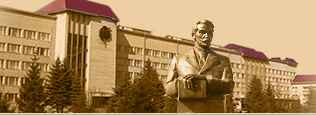APPROACH TO OPTIMIZATION OF THE LANDSCAPE AND ENVIRONMENTAL ORGANIZATION OF THE TERRITORY (ON THE MATERIALS OF THE NOVYKIVSKA VILLAGE COUNCIL, ZBARAZH REGION)
The questions of optimization of the landscape and ecological organization of the territory (on the materials of the Novykivska village council, Zbarazh region) are considered. The landscape and ecological priorities for the given territory are identified, taking into account the current ecological situation in the Novykivska village council, its production specialization, the uniqueness of natural conditions, the degree of preservation of natural landscapes, general trends and needs of socio-economic development. An analysis of the structure of the land in the territory of the Novykivska village council has been carried out, which showed its differentiation and deviation of its scientifically substantiated norms due to the high plowing of the territory. Thus, the share of lands under natural vegetation is only 5,25%, while for agricultural land – 83,4%, and under urban and industrialized lands – 11,38%The estimation of scale and depth of anthropogenic transformation of landscapes has made it possible to determine the priority measures for the protection, support and reproduction of their environmental sustainability in order to create cultural landscapes at the local level. Among the main areas of optimization of nature use are: optimization of land use structure by eliminating unproductive and unproductive arable land in the category of hayfields or pasture; reduction of the share of arable land due to the arrangement of territories with steepness of slopes more than 7 degrees for the afforestation.On the basis of definite and scientifically substantiated norms of optimal arable land, perennial plantations, hayfields, pastures in agrolandscapes, ways of optimizing their use were proposed. The estimation of the coefficient of anthropogenic transformation of landscapes has shown that in the existing structure of land use in the territory of the Novykivska village council this coefficient is 6.75 – strongly -transformed landscapes.The measures to be implemented for optimizing nature use are proposed: to arrange water protection zones, to clean sources, to clear the riverbeds, to plant trees on the territories with steepness of slopes more than 7 degrees, and to organize a recreational zone near the pond.The coefficient of anthropogenic transformation of landscapes after optimization of the structure of land use will be 5.25 – transformed landscapes.
Key words: landscape, optimization, landscape and ecological organization, territory, anthropogenic transformation.
References:
- Voronenko V.I. Naukovo-metodychni pidkhody do optymizatsii ta efektyvnoho vykorystannia zemelnykh resursiv [Elektronnyi resurs]/ V.I. Voronenko // Efektyvna ekonomika : elektronne naukove fakhove vydannia, – Dnipropetrov. derzh. ahrarnyi un-t – Dnipropetrovsk, 2012. – №7. – Rezhym dostupu: http://www.economy.nayka.com.ua/index.php?op=1&z=1286.
- Hofman K.Kh. Sotsyalno-эkonomycheskye aspektы razrabotky rehyonalnыkh prohramm pryrodopolzovanyia / K.Kh. Hofman / Sotsyalyzm y pryroda. — M:Mыsl, 1982. — № 5. — S. 93– 120.
- Hrodzynskyi M.D. Osnovy landshaftnoi ekolohii: pidruchnyk / M.D. Hrodzynskyi. – Kyiv : Lybid, 1993. – 224 s.
- Denysyk H.I. Seletebni landshafty Podillia / H.I. Denysyk, O.I. Bachynska. – Vinnytsia : Vydavnytstvo «Teza», 2006. – S. 67–74.
- Dokuchaev V.V. Nashy stepy prezhde y teper / V.V. Dokuchaev. – sob. soch. – Moskva: Selkhozghyz, 1949. – 152 s.
- Ysachenko A.H. Landshaftы / A.H. Ysachenko, A.A. Shliapnykov. – Moskva: Mыsl, 1989. – 503 s.
- Mylkov F.N. Rukotvornыe landshaftы. Rasskaz ob antropohennыkh kompleksakh / F.N. Mylkov. – Moskva : Mыsl, 1989. – 503 s.
- Mukhyn Yu.P. Ustoichyvoe razvytye: эkolohycheskaia optymyzatsyia ahro- y urbolandshaftov : ucheb. posob. / Yu.P. Mukhyn, T.S. Kuzmyna, V.A. Baranov. – Volhohra : Yzd– vo VolHU, 2002. – 122 s.
- Odum Yu. Эkolohyia / Yu. Odum // Trudы: v 2 t. – Moskva: Myr, 1986. – T. 1. – 326 s. ; T. 2. – 376 s.
- Pysarenko V.M. Osnovni pidkhody do optymizatsii struktury ahroekosystem / V.M. Pysarenko, A.V. Kalinichenko, Yu.V. Shmyhol // Ahroekolohichnyi zhurnal. – 2005. – № 4. – S. 3–6.
- Reimers N.F. Эkolohyia : teoryy, zakonы, pravyla, pryntsypы y hypotezы / N.F. Reimers. – Moskva : Rossyia Molodaia, 1994. – 367 s.
- Reimers N.F. Pryrodokorystuvannia: clovnyk-dovidnyk / N.F. Reimers. – Moskva : Dumka, 1990. – 637s.
- Svynko Y. Narys pro pryrodu Ternopilskoi oblasti: heolohichne mynule, suchasnyi stan. / Y. Svynko. – Ternopil: Navchalna knyha – Bohdan, 2007. – 192 s.
- Tsaryk L.P. Ekoloho-heohrafichnyi analiz i otsiniuvannia terytorii: teoriia i praktyka (na materialakh Ternopilskoi oblasti) / L.P .Tsaryk. – Ternopil: Navchalna knyha – Bohdan, 2006. – 256 s.
- Chybylёv A.A. Эkolohycheskaia optymyzatsyia stepnыkh landshaftov / A.A. Chybylёv. – Sverdlovsk: Yzd– vo UrO RAN, 1992. – 172 s.
